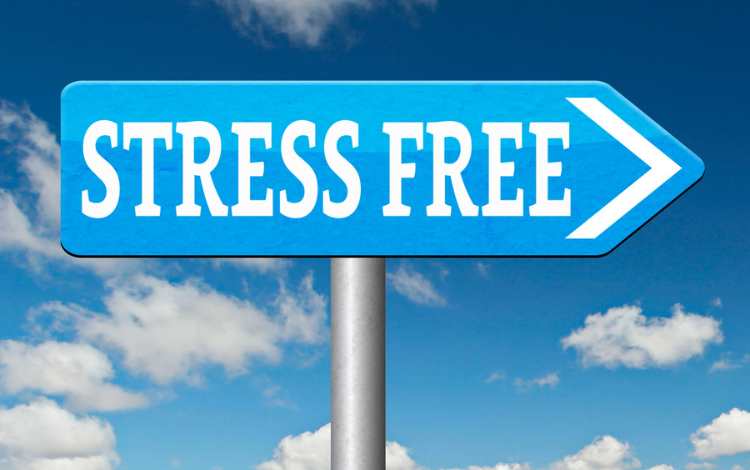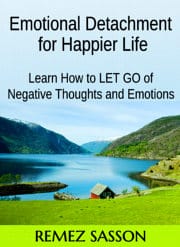
Emotional detachment is a valuable skill that can help you lead a happier and stress-free life. It allows you to maintain your inner peace and resilience in the face of life’s challenges and emotional turmoil.
Emotional detachment means letting go and not taking things personally. It is one of the essential steps toward inner peace.
Short Guide for the Basics of Emotional Detachment
This short and straightforward guide provides simple steps to practice emotional detachment in your daily life, drawing inspiration from the principles outlined in the book “Emotional Detachment for a Happier Life.
Step 1: Self-Awareness
Browse our online courses on meditation, positive thinking, overcoming procrastination, confidence, and freedom from distractions.
The first step is self-awareness. Take time to reflect on your emotions and recognize how they affect your thoughts, behaviors, and overall well-being. Also, pay attention to your emotional triggers and patterns.
Do so several times a day when you can find a few minutes to be alone. Also, try to do so when you feel angry, agitated, unhappy, or frustrated.
Step 2: Practice Acceptance
Accept that you cannot control everything in life. Understand that some events are beyond your control; trying to control them will only lead to frustration and stress.
Focus on what you can control – your reactions, responses, and attitude.
Step 3: Set Boundaries
Establish healthy boundaries in your relationships and clearly communicate your needs and limits to others.
This will prevent you from becoming overly enmeshed in your and other people’s emotions and allow you to maintain your emotional balance.
Related: Consciousness, How to Set Boundaries and Why Setting Them Is Important.
Step 4: Detach from Outcomes
Detach from the outcomes of your actions. Focus on doing your best without becoming overly attached to the results.
This mindset shift can reduce anxiety and stress related to achievement and success.
Step 5: Don’t Take Things Personally
Practicing emotional detachment also involves not taking things personally.
Understand that people’s words and actions often reflect their own thoughts, emotions, and experiences rather than a direct judgment of your worth or character.
When you don’t take things personally, you create a buffer between yourself and the opinions or behaviors of others.
This enables you to maintain your emotional equilibrium even in challenging interactions.
Instead of internalizing criticism or negative comments, consider them as reflections of the speaker’s perspective, and choose not to let them define your self-esteem or emotional state.
This shift in mindset can significantly contribute to a happier and stress-free life.
Step 6: Develop Emotional Resilience
Emotional detachment doesn’t mean suppressing your emotions. Instead, develop emotional resilience by allowing yourself to feel emotions without being controlled by them.
This resilience will help you bounce back from setbacks more easily.
Step 7: Don’t Dwell on the Past
One of the key aspects of practicing emotional detachment is not dwelling on the past. Holding onto past grievances, regrets, or negative experiences can hinder your ability to stay emotionally balanced in the present.
Here’s how to apply this principle:
- Let go of past mistakes: Understand that everyone makes mistakes, and dwelling on them won’t change the past. Instead, focus on what you can learn from these experiences to improve in the future.
- Forgive and release grudges: Holding onto grudges or resentments can consume your emotional energy. Practice forgiveness, not just for others but also for your own peace of mind. Letting go of grudges is an essential part of emotional detachment.
- Live in the present moment: Train your mind to be present in the here and now. Avoid ruminating on past events or worrying excessively about the future. Mindfulness practices, such as meditation and deep breathing, can help you stay grounded in the present.
By not dwelling on the past, you free up mental and emotional space to enjoy the present moment and look forward to the future with a positive and detached perspective. This further contributes to your journey towards a happier and stress-free life.
Related: Consciousness, Awareness, and Your Real Essence.
Step 8: Don’t React Immediately
In practicing emotional detachment, it’s crucial to learn not to react immediately to emotional triggers or intense situations.
Instead of letting your emotions dictate your immediate response, take a moment to pause and reflect. This brief pause enables you to regain control over your reactions and make more thoughtful decisions.
During these moments of reflection, you can choose a response that aligns with your emotional detachment goals.
Remember that emotions are like passing clouds; they come and go. By delaying your reactions, you give yourself the space to respond in a way that is more aligned with your long-term well-being and goals for a happier, stress-free life.
Step 9: Mindfulness Meditation
Mindfulness meditation is a powerful tool for practicing emotional detachment. Dedicate time each day to sit in silence and observe your thoughts and emotions without judgment.
This practice will help you become more aware of your feelings and reduce their control over you.
Conclusion
Emotional detachment is a skill that can significantly improve your quality of life.
I hope this concise guide helps you to make the first steps toward a stress-free life.
Follow these steps, and you will find that you can deal better with setbacks, problems, and stressful people.
For an in-depth understanding of this topic and step-by-step guidance, we recommend reading and practicing the book “Emotional Detachment for a Happier Life“, which you can find here on this website.
You can learn to detach from overwhelming emotions, reduce stress, and lead a happier and more balanced life. Remember that this is a journey, and it may take time to master emotional detachment fully, but the benefits are well worth the effort.
Image source – DepositPhotos
Browse our online courses on meditation, positive thinking, overcoming procrastination, motivation, confidence, and freedom from distractions.


